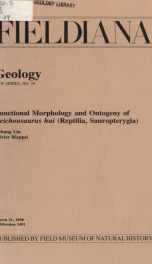Functional morphology and ontogeny of Keichousaurus hui (Reptilia, Sauropterygia) Fieldiana, Geology, new series, no. 39

Keichousaurus hui Young, 1958, from the Middle Triassic of Guizhou, China, is a small sauropterygian reptile. It has a short snout and elongated temporal openings, resembling the European pachypleurosaurid Dactylosaurus. Unlike all other stem-group eosauropterygians, the parietal foramen is displaced anteriorly. The neck is long and flexible. The body is rigid and the bones pachyostotic. There are two or three sacral vertebrae. There is distinct sexual dimorphism, as in Alpine pachypleurosaurids. The broad ulna is autapomorphic for Keichousaurus. The growth of the humerus is highly positively allometric, reflecting the principal role of the forelimb in locomotion. The overall horizontal orientation of the pectoral girdle indicates that Keichousaurus was not a subaquatic flyer. Instead, a drag-based regime was used in locomotion Includes bibliographical references (p. 34-35) Keichousaurus hui Young, 1958, from the Middle Triassic of Guizhou, China, is a small sauropterygian reptile. It has a short snout and elongated temporal openings, resembling the European pachypleurosaurid Dactylosaurus. Unlike all other stem-group eosauropterygians, the parietal foramen is displaced anteriorly. The neck is long and flexible. The body is rigid and the bones pachyostotic. There are two or three sacral vertebrae. There is distinct sexual dimorphism, as in Alpine pachypleurosaurids. The broad ulna is autapomorphic for Keichousaurus. The growth of the humerus is highly positively allometric, reflecting the principal role of the forelimb in locomotion. The overall horizontal orientation of the pectoral girdle indicates that Keichousaurus was not a subaquatic flyer. Instead, a drag-based regime was used in locomotion Fieldiana series has been published as Geological Series by Field Columbian Museum (1895-1909) and Field Museum of Natural History (1909-1943), and as Fieldiana: Geology by Chicago Natural History Museum (1945-1966) and Field Museum of Natural History (1966-1978). Fieldiana Geology New Series No. 1 began June 29, 1979
Info about the book
Author:
Series:
Unknown
ISBN:
0226313379
Rating:
3.5/5 (5)Your rating:
0/5
Languge:
English
Users who have this book
Users who want this book
What readers are saying
What do you think? Write your own comment on this book!
write a commentif you like Functional morphology and ontogeny of Keichousaurus hui (Reptilia, Sauropterygia) Fieldiana, Geology, new series, no. 39 try:
Other books by this author
Do you want to exchange books? It’s EASY!
Get registered and find other users who want to give their favourite books to good hands!









